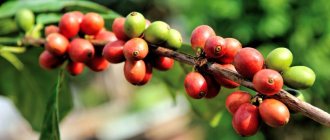general description
Coffee trees belong to the Rubiaceae family. Traditionally, they are divided into several types according to the type of grains obtained. For the consumer, the difference comes down to taste. Most coffee comes from a plant called Arabian coffee (or Arabica) , the second most popular species of Congo coffee (or Robusta). The taste of the latter has a fairly pronounced sourness.
Coffee tree in nature. Ethiopian Harar variety, Arabica
Typically, Arabica is a low-growing plant, and Robusta is a tall plant . But under different growing conditions, it is quite possible that the growth of Arabica will not be inferior to that of Robusta (for example, Arabica grown in the Hawaiian Islands).
Congolese coffee. Karamu variety, Robusta
The fruits of the coffee tree, or coffee beans, are structured exactly the same for all representatives of coffee trees and differ only in size and flavor. The core of coffee beans, actually the seed of the fruit, is the very substance from which the well-known drink is obtained. Depending on the type of coffee tree, from each of them you can get from 0.2 to 10 kg of coffee beans per season.
Opened coffee fruit with two beans inside
There are about a hundred species of the Rubiaceae family in the world, growing in different parts of the globe.
Some of them can be adapted for growing at home in our area. The main problem in growing is not providing the temperature or lighting conditions for the coffee tree; coffee thrives at temperatures from +20°C to +24°C and can be grown in the shade.
The problem is creating the necessary atmospheric pressure for growing coffee, because under natural conditions it grows at altitudes from 900 to 2500 meters above sea level; and this is neither more nor less, a few hundred millimeters of mercury difference. However, this is only critical for industrial coffee growing. We are not chasing an abundant coffee harvest in a temperate continental climate, are we?
Preparing the soil for cultivation
Coffee loves acidic soils, which corresponds to the conditions of its homeland. The pH level for coffee should be between 4.5 and 5.5. At the same time, some gardeners recommend using soils for azaleas, hydrangeas or rhododendrons for coffee trees at home. However, you should pay attention to the acidity level.
If it is slightly higher than recommended (for example, soil pH for azaleas is 4.0), it can be used to grow a coffee tree, but if the soil is highly acidic (pH = 3.5), then it is better not to do this.
Fruiting coffee tree (Arabica), grown at home
Sometimes inexperienced gardeners purchase soil suitable for growing citrus fruits for a coffee tree. It is only partially suitable for the coffee tree, since its composition is acceptable, but it is more neutral than slightly acidic. You also need to know that approximately six months to a year after the start of active growing season, the soil under the coffee tree changes its composition and ceases to be acidic, shifting to neutral acidity.
In both of the considered cases, to ensure a normal acidity level for coffee, it is recommended to “acidify” the soil once a month. This is best done with lemon juice in a concentration of 3-4 drops per 1 liter of water. If you don’t have lemon on hand, you can use citric acid (2-3 grains per 1 liter of water).
The roots of the coffee tree are quite long, penetrating deeply into the soil. To ensure they have adequate supply of nutrients and air, it is necessary to use well-drained and loose compounds. The matted soil must be loosened and humus or peat added to it (depending on the acidity).
You can prepare the soil yourself. For this you will need:
- turf soil – 1 part
- leaf soil - 1 part
- humus - 1 part
- coarse river sand – 1 part
- peat – 2 parts
Sometimes it is recommended to add 0.5 parts of sphagnum moss to this composition for greater looseness.
Growing from cuttings
There are 2 methods of obtaining new shrubs: from seeds and cuttings. The best way to grow a coffee tree is by planting cuttings. With this method, the plant will grow faster, flowering begins earlier, and after 12–24 months the first fruit grains appear. For seeds, this period will last 36–48 months.
The cutting takes root more easily, after rooting it will grow well in width, and it is easier to form a crown on such a seedling. Planting is not labor intensive and does not require special skills. After a few years, shoots can be cut from the ornamental plant for sale or propagation.
How to choose a seedling
Basic rules for choosing cuttings:
- carefully inspect the plant for damage;
- the leaves should be bright green, there should be no spots, holes or dents;
- there must be foliage on the trunk;
- check for insect pests and diseases.
The Nana variety is suitable for growing as an ornamental plant; it does not produce fruit, but is distinguished by bright and rich buds. The Arabica variety is chosen to obtain coffee beans: its spectacular appearance will also be a beautiful decoration for the home.
When purchasing a seedling in a store in winter, the plant must be insulated to prevent freezing outside. To protect the young specimen, use paper or a plastic bag.
How to plant
In order for the coffee tree to take root and be able to harvest in the future, planting should be done correctly:
- It is better to use a ready-made substrate for citrus plants as soil.
- Take a small pot: for the first planting (12 by 8 cm).
- Drainage (pebbles, pebbles, crushed stone, broken brick) is poured into the bottom of the flowerpot.
- The lower part of the cutting must be kept in a growth stimulator for 12 hours.
- The shoot is placed in moist soil.
- Cover it (with a large jar, cellophane) and create greenhouse conditions.
- Place in a warm (+22…+25°C) and illuminated area.
- Periodically open it slightly for ventilation and remove condensation from the lid.
- If necessary, water and spray with settled water.
- After 3–4 weeks, new leaves will begin to grow, and the plant is freed from greenhouse conditions.
Planting coffee seeds
Coffee can be grown either from seeds or from cuttings. Cuttings, of course, are preferable, since it is quite possible to make it bloom and bear fruit in the first year, however, they are not always possible to find.
Coffee seeds
Coffee seeds have relatively good germination, but only in the first days, sometimes weeks after being picked from the branches. Over time, germination deteriorates significantly. Therefore, if you buy grains for planting, their quantity should be quite large.
The percentage of germinated seeds for coffee is generally considered to be around 10%.
Seeds are prepared for planting as follows: the grain is cleared of the outer shell and soaked in a 0.2% solution of potassium permanganate. After which it is dried and planted in a small individual pot.
Arabica young shoots
Later, when the shoot grows enough, it is transplanted into a stationary pot. The composition of the soil in pots should be the same as for growing an adult tree.
Planting is carried out according to the standard scheme: a third of a small pot is drainage (egg shells, small pebbles, gravel), then soil is laid in which a hole 1 cm deep is made. The grain is placed in this hole with the flat side down and covered with a layer of soil. This position of the grain will allow it to break through to the surface with less problems.
Sprouted coffee beans
After planting, it is recommended to create greenhouse conditions for the grains (humidity about 90-95%, temperature about +25°C). Such conditions can be achieved either in a mini-greenhouse, or by placing pots with grains in the sun and covering them with plastic film or glass. Once a day, it is necessary to ventilate the soil surface by removing the film or glass for 5-10 minutes.
Planted grains are watered abundantly, however, watering must be done using a tray. It is prohibited to pour water from above onto the ground. Watering is carried out once every 2-3 days; The criterion for the need for watering is dry soil on top of the pot. The soil should not be allowed to dry out.
How to plant correctly
This plant should be protected from sudden temperature changes and exposure to drafts. With proper care, the crop will bloom and bear fruit profusely.
Selection of capacity
The crop should be planted in a tall pot. A high-quality drainage layer is of no small importance. The roots of the culture grow downwards.
Soil requirements
The tree should be grown in a loose and acidic substrate. It is best to mix coarse sand, crushed coal, humus, and peat. These components are taken in equal parts.
Planting scheme
It is best to grow a crop from a grain. It should not be fried. To plant a plant, do the following:
- Soak the grain in a solution of hydrochloric acid or lightly saw it.
- Place the grain in a growth stimulator.
- Moisten and loosen the soil. Plant a seed. It should not be deepened too much.
- Place the pot in a lighted place. The temperature should be more than +20 degrees.
See also
Rules for planting and caring for alocasia at home
First transplant
If everything was done correctly, the first shoots will appear within the next 4-6 weeks. As soon as the plant reaches a height of 2-3 cm, it must be accustomed to room temperature. First you need to increase the ventilation time by 2-3 times.
Every day the ventilation time must be increased in order to reduce the time the plant stays in the greenhouse to zero within a month. In principle, by that time (2-2.5 months after planting) a small coffee tree with 3-5 fully developed leaves will have already been formed, which needs to be transplanted into its own individual pot.
The diameter of the first pot for a coffee tree should be at least 15 cm with a height of about 20-22 cm. Just like a pot for seedlings, it should be one third filled with drainage, which is expanded clay or small crushed stone. The soil level should be 1.5-2 cm below the height of the walls of the pot.
Coffee tree 3-4 months old in individual pots
It is best to choose clay or ceramics as the pot material, since additional air supply to the roots will not hurt, however, since the root system when grown at home is very close to the surface, this does not play a special role.
Plant care
Conditions of detention
The living conditions of the coffee tree are quite simple: in summer the temperature should be between +22°C and +25°C, and in winter at least +15°C. Lowering the temperature is detrimental to the plant.
Coffee before transfer
However, it is also not worth exceeding temperatures above +25°C: in its natural habitat, coffee grows in the shade or partial shade of taller plants, therefore, despite the equatorial climate, it constantly remains in average temperatures. An increase in temperature also has a detrimental effect on the condition of the tree, as it leads to the evaporation of moisture from the leaves and their yellowing, followed by death.
Coffee trees in partial shade conditions
It is not recommended to place the coffee tree pot in direct sunlight. The light should be diffused.
On the other hand, you should not place the plant on eastern or western windows either - after all, in our climate the amount of sunlight is less than at the equator. Therefore, the ideal option would be to use partial shade or a diffuser (for example, in the form of curtains) on south-facing windows. As a rule, artificial light for coffee is not used during the active growing season.
The coffee must not be rearranged or moved. The only exception is when the tree is replanted. It should be remembered that even a slight rotation of the tree around its axis can lead to the cessation of flowering and the fall of leaves.
Flowering of a coffee tree grown from beans usually occurs in the 3-4th year of cultivation. By this time, the plants will already be quite tall and will have already been replanted at least twice. Sometimes it is recommended to provide flowering plants with direct sunlight for 1-2 hours a day.
Naturally, the pot with the plant remains in place; all obstacles between the tree and the Sun are simply removed.
Watering
Coffee loves moisture very much. Watering should be sufficient in both winter and summer. The criterion for the need for watering is the formation of a crust on the top layer of soil. Usually, in the summer, 1 watering every 2-3 days is sufficient. In winter, watering is reduced to once every 5-6 days. You should not over-water the soil - like most plants, coffee does not like stagnation of water in the roots.
Once a week it is recommended to spray the leaves of the coffee tree with a spray bottle.
This should be done in the morning or evening. Moisture should not be removed from the leaves after the procedure. Both watering and spraying are done with settled or boiled water at room temperature. This must be done to avoid any alkali getting into the plant and soil; After all, it should be remembered that the coffee plant is “sour”.
Feeding
The ideal fertilizer for a coffee tree is mineral liquid fertilizers for citrus fruits, sold in any flower shop. As a preventative measure, such fertilizers are applied every 15 days during the most active growth of green mass (from April to September). During flowering, it is recommended to double this dose.
The coffee tree must be fed regularly to ensure its full growing season and flowering.
You also need to remember that all crops that prefer acidic soils sooner or later “eat away” almost all the iron from the substrate in which they live. Therefore, it is necessary for plants to compensate for the lack of this element; To do this, once a year (for young plants - every six months) it is necessary to add iron preparations to the soil in the required dosage.
Subsequent transplants
The plant quickly selects all the necessary substances from the substrate, it has a high growth rate of the root system, so it requires annual replanting. After 3-4 years, replanting can be done every 2 or 3 years, annually only changing the top layer of the substrate.
Usually, transplantation is done into a pot with a diameter of 2-4 cm and a height of 1-3 cm greater than the previous one.
It is recommended to use soil for azaleas (or any other similar plants) for the first two transplants, and subsequent transplants to be done in soil prepared independently with the addition of additional raising agents (sphagnum moss).
Flowering and fruiting
Usually, before the first flowering, the coffee tree is pruned a little. This procedure has two goals: to shape the appearance of the plant and to stimulate it to flower. Typically, flowering occurs when the plant height is between 50 and 60 cm.
Coffee tree 4 years old
There are two methods of circumcision, each of which has its own goals. Either the growth cone is removed to ensure greater branching of the tree, or, conversely, the lowest branches are removed so that the plant accelerates its growth.
Traditionally, the first method is used more often when the plant’s growth exceeds 60 cm. The best time to carry out the procedure is early April, 1-2 weeks before the active growing season.
Approximately 1-2 weeks after pruning the plant, green tendrils appear in the axils of the leaves. These are the beginnings of future buds. Often their number is very large, from a few pieces to two dozen. It takes about a month for the buds to form, after which they bloom within 1-2 days.
Coffee tree flowers
Fruit ripening occurs within approximately six months. The beans remain green until approximately February of the next year, then turn white, and after that they take on the color of ripe fruit. It can be brown, red or yellow.
In the first season, the harvest will be small - about 70-100 fruits; each fruit contains 2 coffee beans.
Drying of grains is carried out at a temperature of about +70 – +80°C. After which they should “rest” at room temperature for about 1-2 weeks on paper; The grains are placed in one layer.
Ready-to-drink coffee beans. Colombian Arabica
The further procedure for preparing the grains is to fry them in a frying pan until they turn brown. After this, they can be used to prepare a drink.
How to Grow a Coffee Tree
Watering and fertilizers. Warm, settled water is used for irrigation. Some gardeners recommend acidifying it a little by adding a few drops of lemon juice. Watering for coffee requires moderate watering. The plant is calm about drying out the earthen clod, but in summer it is advisable to water it as the top layer of soil is added, and in winter - about once a week. The lack of moisture is immediately noticeable by the loss of turgor in the leaves. In summer, the soil can be mulched to help it retain water better.
The indoor plant Coffee tree loves spraying; it is advisable to do it in the evening. It would be useful to periodically add leaf fertilizers and growth stimulants to the water: Epin, Zircon.
Coffee has virtually no dormant period, so it can be fertilized all year round, approximately once every 10 days in summer and every 20 days in winter. What this plant needs most is nitrogen, the best source of which is manure. It can be applied immediately when the coffee tree needs replanting.
Propagation using cuttings
Cuttings must be made between the end of February and the beginning of March. On average, it takes about a month to root a cutting.
The advantages of cuttings over growing coffee from seeds are as follows:
- rooting occurs in almost 100% of cases
- unlike seed propagation, the plant inherits all the characteristics of the maternal
- flowering and fruiting may occur in the same year (but, nevertheless, more often occurs the next)
- the fruits of the first harvest are larger and there are more of them
- Cuttings are made from branches from the middle of the crown of an already fruit-bearing tree. The cutting is cut at a distance of about 3 cm from the first pair of leaves. At a distance of 3-5 mm from the cut, several additional cuts are made on the cutting, necessary for better root formation.
- The cutting is placed for several hours in a reteroauxin solution (a quarter of a tablet per 1-1.5 liters of water); A similar solution stimulates the formation of roots in the cuttings.
- After which the cuttings are planted in a substrate (the same as that of the mother plant) to such a depth that the first leaves of the cutting touch the level of the substrate.
- Next, the pot with the cutting is closed with a plastic bag, in which several holes with a diameter of 2-3 mm are made to provide air access.
- Once a day, the cuttings are ventilated and watered by spraying the leaves with water at room temperature.
- The plant should be in partial shade with a temperature between +22° - +25°C.
Cuttings with a formed root system
At the end of the root system formation procedure, it is necessary to transplant the cutting into its stationary pot. The transplant procedure is similar to that described earlier. After replanting, it is necessary to apply the usual fertilizing to ensure the growth of the green part of the plant.
Tree diseases
Coffee is a fairly hardy plant and, with proper care, its immune system copes well with diseases and pests, however, cases are different, so you should not hope that everything will work out.
Well-growing domestic trees
The main problem for the coffee tree is excessive dryness of both the substrate and the air. Maintaining these parameters must be monitored first.
In any case, you need to be prepared for any whims, since it is not always possible to replicate the conditions that correspond to natural conditions for a coffee tree.
Coffee diseases include the following:
Brown rust
Caused by a fungus of the genus Himelia. Externally, the leaves are covered with large brown spots, which turn brown in the middle, spreading to the entire leaf. They are often difficult to notice because the lower part of the leaf is affected.
To prevent leaf rust, you should inspect the leaves daily from all sides and, if the first symptoms appear, spray the plant with fungicides. At the same time, the fungus can persist in the soil for a long time; it also needs to be treated with an antifungal agent. Sometimes the affected leaves have to be removed completely.
Coffee leaf with brown rust
If the disease comes again, it is necessary not only to treat the plant, but also to transplant it into another container.
spotting
Caused by a fungus of the genus Omphalia
Forms yellowness on the leaves, has a high spread rate and is more dangerous in impact than leaf rust. In addition to the leaves, it damages the stem and fruits. It helps to completely trim the affected areas and treat the remaining wood with Bordeaux mixture.
Gommoz
A disease caused by bacteria that results in leaf damage and a brown color. The leaves not only change color, but also become wrinkled and dry out quickly. After the leaves, the rest of the plant is affected.
To combat gommosis, it is necessary to remove the damaged areas, the rest is treated with copper sulfate. The plant must be moved to another place (even despite the danger of partial loss of fruits and leaves) and its conditions of maintenance must be reviewed.
Root rot
Despite the name, the symptoms are also determined by the foliage. At the same time it becomes gray.
The plant needs to be replanted as soon as possible, after first inspecting the root system and removing damaged areas
The remaining healthy root system is treated with a 0.2% solution of potassium permanganate before transplanting.
Pests
Whitefly on a coffee leaf
Of the pests for indoor Arabica, the most dangerous are whiteflies. These are very small flying insects that resemble moths. When they appear on the leaves of the coffee tree, cobwebs and a white coating form. If pests are detected, you should immediately begin to destroy them. The danger is that they multiply very quickly and destroy the plant, sucking the juice out of it.
For treatment, it is necessary to wash all the leaves with a solution of green or laundry soap. After this, you can spray with an infusion of garlic, onion, tobacco or wormwood. In especially severe cases, an insecticide solution is used. In the same way, they fight scale insects, aphids and mealybugs, which can also infect the plant.
As can be seen from the above, the coffee tree is an exotic plant, but caring for it does not require much time and effort. The main thing is to follow the rules of maintenance, and then you will receive not only an original decoration of the room, but, over time, your own small coffee plantation.
Varieties of coffee trees
Currently, several dozen different varieties of coffee trees are cultivated. In fact, they are hybrids of several species of coffee trees, obtained both naturally and artificially. They differ in size, taste and aroma of beans.
If the grower has a preference for the type of coffee variety consumed, you can choose and grow a tree of that same variety
Actually, the main division of coffee varieties is made precisely according to the varieties of these trees. Let's consider varieties of coffee trees that have a high probability of living relatively comfortably at home:
Variety Typica
Actually, that’s where it all started. Typica is the main Arabica variety and the first wild coffee tree in Africa to be cultivated by humans. Despite the relatively low yield, it is very popular among coffee producers because it has some of the most unpretentious growing conditions.
Branches of the Typica variety
The plant can be grown not only in the sun, but also in the shade. Therefore, the technique of growing it is called “shadow growing.” It was Typica, thanks to its unpretentiousness, that perfectly adapted to the conditions of Brazil, El Salvador, Yemen and even Vietnam.
The size of the Typica fruit reaches 13-14 mm, the size of the beans is 5-7 mm . On one branch of a bush (or tree), located in a horizontal rather than a vertical plane, there can be up to 200 grains. The height of the plant rarely exceeds 3.5 m, the yield is about 1 kg of finished coffee beans. Actually, Arabica coffee trees rarely reach such a height; usually, these are relatively short trees (often even bushes), about 50-90 cm in height.
At home, all this has to be divided into two: the actual maximum height of Typica coffee trees is about 2 m (well, the average is from 30 to 50 cm), the yield is 300-500 g of finished beans.
Ripe fruits of the Typica variety
Beginning gardeners are recommended to grow Typica as their first experience, since there are the fewest problems with it and there is a high probability of achieving not only a good growing season, but also flowering of the plant and its fruiting.
Variety Maragogyp
This is one of the Arabica varieties with particularly large grains. Sometimes it is called “Elephant variety”. The fruits of Maragojipa can reach 30 mm, and its grains - 15-20 mm. This does not affect the height of the plant in any way; it remains the same as that of classic Arabica (trees or bushes up to 1 m in height). This type of coffee has a pronounced chocolate flavor.
Branches of Maragojipa
The peculiarity of this variety is its non-African origin. It was obtained as a natural mutation of Typica, grown in Brazil. By some mysterious coincidence, the conditions in the area of the city of Maragogip turned out to be better for Arabica than those present in its homeland.
The variety has taken root well in other countries of South America; in addition, due to some climate characteristics of the area in which it is grown, the taste of its grains has characteristic differences:
- Nicaragua – pronounced aroma and slight sourness
- Mexico and Colombia - peanut flavor
- Guatemala – weak chocolate taste, maximum similarity to classic Typica
In theory, Maragogipe has even greater adaptability than classic Arabica. It might be worth trying to start growing a coffee tree with it.
Bourbon
It is a variety of Arabica, developed in South America, but reintroduced to Africa. It has somewhat larger grains compared to the same Typica (by 1-1.5 mm). In addition, its taste is sweeter and more balanced.
Bourbon fruits are more variegated compared to Arabica: bright red or bright yellow. There are practically no visual differences in the form of the trees themselves. Bourbon is interesting because, firstly, it has greater survivability than many Arabica varieties, and secondly, it produces about a third more yield than Typica. However, it is sun-loving, and therefore requires appropriate growing conditions.
Ripe yellow Bourbon berries
Within this variety, there are about 3-4 varieties, differing in taste (sometimes very radical) and grain size. However, the agricultural technology of all representatives of Bourbon is absolutely the same. The plant has relatively good adaptability and can also be recommended as the first coffee tree to be grown.
Congo variety
Representative of the varieties of coffee trees from which Robusta is obtained. The Congolese coffee tree is truly a tree whose normal growth starts at two meters and can reach up to ten. The fruits are quite large (from 8 to 15 mm), up to tens of kilograms can be collected from one tree.
Congo coffee tree (robusta)
The trees from which Robusta is obtained are more hardy than those bearing Arabica. They cope well with drought and disease, and are resistant to most pests. However, due to the sourness present in it, the taste of robusta is not suitable for everyone. This explains why cuttings or cultivable Robusta beans are often difficult to obtain.











